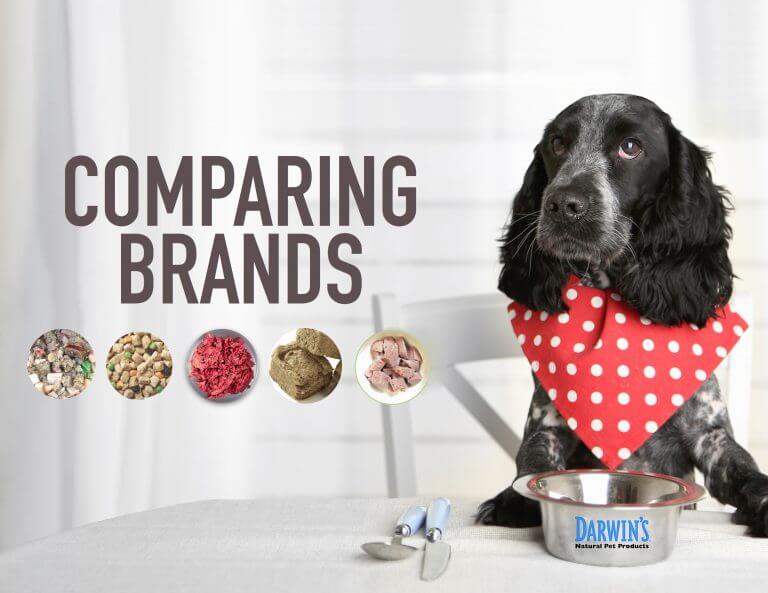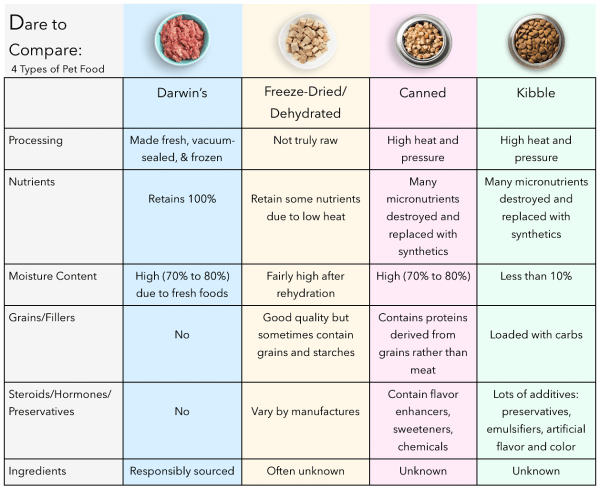How To Compare Dog Food Brands
12/12/17

Darwin’s Guide to Dog Food Comparisons
You want to choose the best dog food—the high-quality, wholesome nutrition that keeps your pet happy, healthy, and filled with energy, all without breaking your budget. But despite scouring the internet for info, walking the aisles in the pet store, and looking at dozens of labels, you may feel like finding the perfect food is an impossible goal.
We feel your pain. To simplify the process of picking pet food, we’ve gathered our best advice in one spot. Read on for helpful advice on deciphering nutritional information, comparing food types, and pinpointing which type of food is right for your best friend.
Dog Food Comparisons: No Easy Feat
If you have ever compared two products in the supermarket, you know what a challenge (and what a headache) this can be. The nutritional info can baffle even the most nutrition-savvy consumer. Although the details of nutritional labels vary between human foods and foods for our pets, it is equally important to be sure you are comparing different products on even footing. Here are a few commonly asked questions:
What’s Up With Confusing Dog Food Labels
In order to compare two pet foods, it is important to compare the “dry matter” nutritional values rather than the “as fed” nutritional values. This is particularly important if they are very different in consistency, such as a raw food and a kibble.
The nutritional information typically listed on any pet food is the “Guaranteed Analysis.” This is the “as fed” nutritional information, which includes crude fiber, crude fat, and crude protein as well as the moisture content of the meals. The word crude, in this case, refers to the method of nutritional testing rather than the quality of the ingredients.
Dog Food Label Comparisons
As you narrow down your food options, read the labels carefully. Here’s what you need to watch for:
- Complete and Balanced Nutrition: Does the food you are considering meet or exceed AAFCO (Association of American Feed Control Officials) standards?
- 100% Real Meat: Is it all meat? Avoid meat by-products, especially in the meat and bone meals where the meat is not identified. Additionally, all meats should be free of hormones, steroids, and antibiotics.
- Whole Vegetables: Food should contain a “rainbow” of whole vegetables to cover all the antioxidants and nutrients needed for a balanced diet. If they claim to be organic, make sure the USDA Certified Organic seal is proudly displayed on the packaging.
- No Fillers or Grains: Period!
- No Preservatives: Avoid foods with BHT, BHA and ethoxyquin (a chemical used to preserve fish meal).
- Essential Minerals: Minerals that are in chelate form are more easily absorbed but cost more. Many brands typically use minerals in sulfate or oxide form which are cheaper but less easily absorbed. More important, make sure there is a careful balance of micronutrients and minerals for each meat. Almost all brands use one mix of minerals for all their meat sources, which can lead to big imbalances.
How Moisture Content Effects Comparisons
The moisture content simply refers to the portion of a food that is water. The value varies widely among kibble, raw, and canned foods. While moisture content is an important component of the meals, it can cause the nutritional values of different types of food to appear misleading. One question people sometimes have is, “Why are Darwin’s meals so much lower in protein than the kibble I am feeding?” The answer is, they probably aren’t!
Achieve An Accurate Comparison Between Two Types of Dog Food
To compare foods on a “dry matter” basis rather than an “as fed” basis, you need to exclude the portion of the food that is moisture.
Consider the table below: Because Darwin’s chicken meal shown in the below table has a 72 percent moisture content, this means the other components of the meal comprise the remaining 28 percent. The “as fed” percentage of protein is listed as 13 percent.
This means that the dry matter protein content of the meals is 13/28 = 46 percent. As you can see, comparing the “dry matter” values of the kibble and Darwin’s meals provides a much different picture than comparing their “as fed” values.
Because Darwin’s meals, as well as most raw or canned foods, have a much higher moisture content than kibble, the protein, and fat content can appear misleadingly low if the two foods are compared using the “as fed” nutritional values (typically listed on the package) rather than the dry matter values.
Once the water is excluded, it is easy to see that Darwin’s meals provide higher levels of both protein and fat than a kibble typically does, even though at first glance using the “as fed “nutritional values, it can appear the kibble provides more of these essential macronutrients.
Comparing the dry matter values of different food types should help give the most accurate picture of how any two foods nutritionally differ. This allows you to more easily make informed decisions regarding your pet’s health and diet.
What To Look For In A Dog Food Brand
As you can see, raw food is a nutritional powerhouse. But you definitely want to consider the logistics before you choose a pet food. If you are considering switching to raw meals to your dog, there are important factors you need to consider:
- Convenience: Is the food only available in stores, or do they deliver to your door?
- Freshness: When was the food made? Keep in mind this is different from the expiration date. While that is important, it doesn’t tell you when the meals were actually manufactured. Unfortunately, this means some of the food may have been frozen and/or stored for a year or more — and those store employees will not have immediate access to that information.
- Affordability: Are you planning to buy raw food in a store? Keep in mind that anytime there are others between packaging and the store shelf (warehouses, distributors, vendors, and so on), the cost will be higher
Darwin’s Pet Foods Dare To Compare
Here’s how Darwin’s raw meals from stack up against freeze-dried and dehydrated pet food, canned pet food, and premium kibble.
Darwin’s Vs. Freeze-Dried or Dehydrated Pet Food
Darwin’s Natural Raw Pet Products Raw Meals
- Darwin’s meals are made fresh, vacuum-sealed, and then frozen 100% raw; there is no heat added at any point in the process.
- Because there is no heat added, Darwin’s food retains 100% of the naturally occurring nutrients found in the ingredients.
- Darwin’s food has a naturally high moisture content due to the fresh vegetables and meats.
- Darwin’s does not contain grains, fillers, or artificial substitutes. Our meals are crafted with 75% real meat and 25% vegetables to provide nutrition from healthy sources.
- Sourced using ingredients from USDA-certified facilities or facilities held to equal or greater standards when outside the United States.
Freeze-Dried or Dehydrated Pet Foods
- Freeze-dried or dehydrated foods often claim they are “raw,” but during the dehydration/freeze-dry process, most companies heat the food—so it is not truly raw.
- Even though heat is used, dehydrated and freeze-dried foods have not been processed with high heat, meaning much more nutritional value has been retained.
- Needs to be rehydrated. Then it will be about 70% to 80% water—much better than dry food and fits the moisture profile of a more natural diet.
- Usually, contain higher-quality ingredients than dry kibbles, but these foods often still contain grains and starches in the form of rice or tapioca.
- The origin of the ingredients in dehydrated and freeze-dried foods is often unknown.
- Freeze-dried and dehydrated food is a healthier option than kibble or canned foods for pet owners unwilling to feed raw.
Darwin’s Vs. Canned Pet Food
Darwin’s Natural Pet Products Raw Meals
- Darwin’s meals are made fresh, vacuum-sealed, and then frozen 100% raw; there is no heat added at any point in the process.
- Because there is no heat added, Darwin’s food retains 100% of the naturally occurring nutrients found in the ingredients.
- Darwin’s food has a naturally high moisture content due to the fresh vegetables and meats.
- Darwin’s does not contain grains, fillers, or artificial substitutes. Our meals are crafted with 75% real meat and 25% vegetables to provide nutrition from healthy sources.
- Sourced using ingredients from USDA-certified facilities or facilities held to equal or greater standards when outside the United States.
Canned Pet Foods
- Canned pet foods are processed with high heat and pressure, destroying many vital micronutrients.
- Canned pet foods use mostly synthetic vitamins to replace the micronutrients lost in the preserving process.
- Canned food typically contains protein derived from grains or grain by-products and sources such as corn gluten meal and wheat rather than protein from real meat.
- Canned pet foods contain flavor enhancers, sweeteners, and other artificial chemicals and preservatives.
- Canned food has a similar moisture content to raw foods (between 70% and 80%).
- The origin of the ingredients in canned foods is unknown.
Darwin’s Vs. Premium Dry Kibble
Darwin’s Natural Pet Products Raw Meals
- Darwin’s meals are made fresh, vacuum-sealed, and then frozen 100% raw; there is no heat added at any point in the process.
- Because there is no heat added, Darwin’s food retains 100% of the naturally occurring nutrients found in the ingredients.
- Darwin’s food has a naturally high moisture content due to the fresh vegetables and meats.
- Darwin’s does not contain grains, fillers, or artificial substitutes. Our meals are crafted with 75% real meat and 25% vegetables to provide nutrition from healthy sources.
- Sourced using ingredients from USDA-certified facilities or facilities held to equal or greater standards when outside the United States.
Premium Dry Kibble
- Premium kibbles are processed with high heat and pressure, which destroys many vital micronutrients the ingredients once contained.
- Premium kibbles use mostly synthetic vitamins and minerals to replace the micronutrients lost in the preserving process.
- Premium kibbles are loaded with carbohydrates (commonly soy, wheat, rice, corn, barley, potatoes, tapioca, or starch) to serve as sources of energy and calories; they often use vegetables as their main source of protein.
- Premium kibbles contain a lot of additives, including (but not limited to) toxic preservatives BHA, BHT, and ethoxyquin to guarantee a 12-month shelf life; emulsifiers to bind fat and water; and artificial flavors and colors to improve appearance and palatability.
- The origins of the ingredients in kibble are unknown.
DARE TO COMPARE: 4 Types of Pet Food




